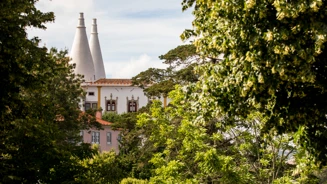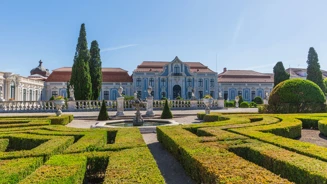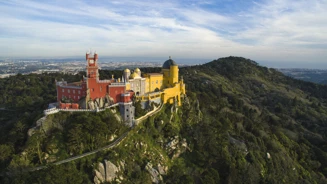How many kings have lived in Sintra?
30 Mar 2023
Construction of the National Palace of Sintra began between the 10th and 11th centuries, even before the founding of the Kingdom of Portugal. Many monarchs have passed through the palace over the course of four dynasties. Another notable royal palace in the municipality is the National Palace of Queluz, which, after the earthquake of 1755, became the official residence of the Court until it left for Brazil during the French invasions. In Sintra, yet another palace inhabited by kings and queens was the National Palace of Pena. This was the favourite intimate refuge of the Royal Family, who enjoyed the cool weather and the quiet of the Sintra hills, away from the court.
So how many kings passed through these three palaces in Sintra in the end? The answer is simple: all of them! There are records that prove the passage of all monarchs through Sintra, even those of the Philippine dynasty, but some left their mark more than others. Here are some examples:
King Afonso Henriques: soon after the conquest of Lisbon in 1147 and the surrender of the Moors in Sintra, the first king of Portugal had a religious structure built that we know today as the Church of São Pedro de Canaferrim. It was also around this time – specifically in 1154 – that King Afonso Henriques granted Sintra a town charter. It was the first municipality to receive such a charter from the king.
King Dinis: as already mentioned, the construction of the Palace of Sintra began even before the foundation of Portugal, but the truth is that the first document attesting to the existence of a palace in Chão da Oliva, as the place was called, dates from 1281. It is a contract between King Dinis and the free Muslims of Colares, in which the king offered to reduce their tax burden in return for them taking care of the palace's upkeep.
Queen Isabel of Aragon: the palace, the town of Sintra and its territory were granted to the wife of King Dinis in 1287. While the property remained in the hands of the crown, the queen became the beneficiary, taking receipt of all income and tax revenues. Thus began the tradition of giving control of Sintra to the kingdom's queens. It was also Isabel who implemented the cult of the Divine Holy Spirit in Sintra. Even today, we find several churches, chapels and festivals dedicated to the Holy Spirit throughout the municipality.
King João I: it was in the Palace of Sintra – a building to which he devoted his greatest attention, ordering one of the largest interventions ever in the palace – that in 1413 the king received the spies sent to the court of Sicily on a supposed diplomatic mission, but whose real purpose was to obtain strategic data on the port of Ceuta. Don't forget that the conquest of this city symbolically marked the beginning of the Portuguese Discoveries.
King Duarte: from the 15th century onwards, Portuguese monarchs began to use the Palace of Sintra with greater frequency. One of the great lovers of this town was King Duarte, who wrote the following: "We come to this town of Sintra many times to have some summers. And so we believe that the kings who come after us will do too, because we find the land of very good airs and waters, and of counties in which there is a great abundance of provisions from the sea and land, and because our very noble and loyal city of Lisbon is so close, and because we have in Sintra a lot of amusement and recreation in the mountains and hunting. And because we have there noble palaces of very wide views."
King Afonso V: the son of King Duarte was born (1432) and died (1481) in the National Palace of Sintra.
King João II: the son of King Afonso V was acclaimed king of Portugal in the Palace of Sintra.
King Manuel I: This king was responsible for some of the most striking changes to the Palace, namely the implementation of Hispano-Moorish tile coverings and the creation of the Room of the Coat of Arms. At the end of his reign, the Palace of Sintra was one of the grandest palaces of the kings of Portugal. And it was precisely in Sintra, in 1501, that King Manuel learnt of one of the great achievements that marked his reign: the discovery of Brazil.
King Philip I (II of Spain): during his stay in Sintra, after visiting the Convent of the Capuchos for the first time in 1581, Philip sent a letter to his daughters that illustrates well what he felt when he arrived at this refuge of the Franciscan friars, 'hidden' in the Sintra hills. "Of all my kingdoms, there are two places that I greatly esteem, Escorial for being so rich, and the Convent of Santa Cruz [known today as the Convent of the Capuchos] for being so poor," wrote the monarch.
King Afonso VI: This is one of the kings probably most associated with Sintra, for the worst of reasons. King Afonso VI was removed from the throne by his brother, the future Pedro II, who claimed that his brother was physically and mentally unfit. After a period of isolation on Terceira Island in the Azores, the deposed king was sent to the Palace of Sintra, where he died after nine years in confinement. It is said that the marks on the floor of the small room where the king was locked up were made by him pacing repeatedly around. Fact or fiction? The answer is here.

King Pedro III: he was still third Lord of the House of the Infantado when he decided to start enlarging the Queluz Country Estate. Later, in 1760, when his marriage to the heiress to the throne, Queen Maria I, was announced, the future King Pedro III decided to further expand the works on this property, giving it the scale of a royal palace and creating a leisure space for the Royal Family, with several state rooms and a sumptuous garden. In essence, it is thanks to King Pedro III that we have the National Palace of Queluz today.
Queen Maria I: after the earthquake of 1755, Maria I made the Palace of Queluz her official residence, as did Prince Regent João VI. The palace was permanently inhabited until the day before the Napoleonic troops arrived in Lisbon in 1807 and the Royal Family left for Brazil.
Queen Carlota Joaquina: with the return of the Royal Family to Portugal in 1821, one would expect the Palace of Queluz to once again become their main residence. But no, it became the residence of Carlota Joaquina, in semi-exile, after being accused of conspiring against her husband.
King Pedro IV: before all that, however, came one of the happier moments at Queluz, with the birth of the future King Pedro IV (King Pedro I of Brazil) in the Don Quixote Room. It was in this same room that he died, aged just 34.
King Miguel: Queluz was also the home (and birthplace) of Pedro IV's brother. During the period of the Civil War, which pitted absolutists (led by Miguel) against liberals (led by Pedro), it was Miguel who inhabited the Palace. The liberals eventually won the war and Pedro was able to return to the house where he was born.

King Ferdinand II: With his personal fortune, Maria II's husband bought an old monastery at the top of the Sintra hills. His aim was to create a refuge for the family, where they could spend long, happy seasons away from the hustle and bustle of Lisbon. Unfortunately, Queen Maria II died before the king-consort could finish his life's great project. That project for the construction of the Park and Palace of Pena turned out to be one of the favourite places of her descendants, Luís I and Carlos.
Queen Maria Pia of Savoy: after becoming widowed from King Luís I, Maria Pia spent extended periods at the Palace of Sintra. Her rooms can still be visited today. Queen Maria Pia was the last monarch to inhabit the Palace. On 3 October 1910, after a dinner with the future president of Brazil, Hermes da Fonseca, Manuel II returned to the Palace of Necessidades and alerted his grandmother to what was happening in Lisbon – the instauration of a Republic. António Teixeira de Sousa, then President of the Council of Ministers, managed to persuade Manuel II to leave Necessidades and take refuge in Sintra or Mafra. It soon became apparent that the environment was not safe.
Queen Amélia of Orléans: the wife of King Carlos was passionate about the Park and Palace of Pena. She used to spend long periods of time exploring nature, sunbathing on the terrace and enjoying the coolness of Sintra. On 3 October 1910, King Manuel II also alerted Queen Amelia to what was happening. The Queen Mother quickly realised that she had to leave Sintra as soon as possible. Thus, on the morning of 5 October, Amelia and Maria Pia left Pena and the Palace of Sintra to join Manuel in Ericeira, thus becoming the last monarchs to inhabit the two palaces. From there, they left for exile. On that same day, the republican regime was established in Portugal.

